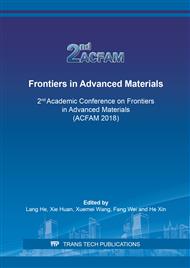[1]
Graham-Brady L L, Arwade S R, Corr D J, et al. Probability and materials: from nano-to macro-scale: a summary[J]. Probabilistic Engineering Mechanics, 2006, 21(3): 193.
DOI: 10.1016/j.probengmech.2005.10.005
Google Scholar
[2]
Klaus F, Stoyko F, Zhong Z. Polymer composites from nano-to macro-scale[J]. Polymer composites, 2005, 5: 51.
Google Scholar
[3]
Oezaslan M, Heggen M, Strasser P. Size-dependent morphology of dealloyed bimetallic catalysts: linking the nano to the macro scale[J]. Journal of the American Chemical Society, 2011, 134(1): 514.
DOI: 10.1021/ja2088162
Google Scholar
[4]
Greer J. Materials by design: using architecture and nanomaterial size effects to attain unexplored properties[C]. Frontiers of Engineering: Reports on Leading-Edge Engineering from the 2015 Symposium. National Academies Press, (2016).
Google Scholar
[5]
Bao G, Xu X. Identification of the material properties in nonuniform nanostructures[J]. Inverse Problems, 2015, 31(12): 125003.
DOI: 10.1088/0266-5611/31/12/125003
Google Scholar
[6]
Fu J, Siham K-B, Fabrice B, Marilyne C, Comparison of mechanical properties of C-S-H and Portlandite between nano-indentation experiments and a modelling approach using various simulation techniques[J]. Composite part B: Engineering, 2018,151:127.
DOI: 10.1016/j.compositesb.2018.05.043
Google Scholar
[7]
Jennings H M. A model for the microstructure of calcium silicate hydrate in cement paste[J]. Cement and Concrete Research, 2000, 30(1):101.
DOI: 10.1016/s0008-8846(99)00209-4
Google Scholar
[8]
Hou D, et al. Calcium silicate hydrate from dry to saturated state: Structure, dynamics and mechanical properties[J]. Acta Materialia, 2014, 67: 81.
DOI: 10.1016/j.actamat.2013.12.016
Google Scholar
[9]
Constantinides, G., and F.-J. Ulm. The effect of two types of C-S-H on the elasticity of Cement-based materials: Results from nanoindentation and micromechanical modeling[J]. Cement and Concrete Research, 2003,34:67.
DOI: 10.1016/s0008-8846(03)00230-8
Google Scholar
[10]
Richardson I G. Tobermorite/jennite- and tobermorite/calcium hydroxide-based models for the structure of C-S-H: applicability to hardened pastes of tricalcium silicate, beta-dicalcium silicate, Portland cement, and blends of Portland cement with blastfumace slag, metakaolin, or silica fume[J]. Cement and Concrete Research, 2004, 34(9):1733.
DOI: 10.1016/j.cemconres.2004.05.034
Google Scholar
[11]
Merlino S, Bonaccorsi E, et al. The real structure of tobermorite 11Å normal and anomalous forms, OD character and polytypic modifications[J]. European Journal of Mineralogy, 2001, 13(3): 577-590.
DOI: 10.1127/0935-1221/2001/0013-0577
Google Scholar
[12]
Fu J, Fabrice B, Siham K-B. First-principles calculations of typical anisotropic cubic and hexagonal structures and homogenized moduli estimation based on the Y- parameter. Application to CaO, MgO, CH and Calcite CaCO3[J]. Journal of Physics and Chemistry of Solids, 2017, 101:74.
DOI: 10.1016/j.jpcs.2016.10.010
Google Scholar
[13]
Fabrice B, Fu J, Siham K-B. Multiscale modeling approach to determine the specific heat of cementitious materials[J]. European Journal of Environmental and Civil Engineering, 2018,1:1.
Google Scholar
[14]
Fu J, Fabrice B, Siham K-B, Lin W. Nano-scale modeling and elastic properties of a typical CSH (I) structure based on Density Functional Theory and Molecular Dynamics Methods. 33èmes Rencontres de l'AUGC, mai 2015, Anglet (France).
Google Scholar
[15]
Hamid S Α. The crystal structure of the 11Å natural tobermorite Ca2.25[Si3O7.5(OH)1.5]·1H2O[J]. Zeitschrift für Kristallographie-Crystalline Materials, 1981,154 (1-4): 189.
DOI: 10.1524/zkri.1981.154.3-4.189
Google Scholar
[16]
Fu J, Fabrice B, Siham K-B. Assessment of the elastic properties of amorphous Calcium Silicates Hydrates (I) and (II) structures by Molecular Dynamics Simulation[J]. Molecular Simulation, 2018, 44(4):285.
DOI: 10.1080/08927022.2017.1373191
Google Scholar
[17]
Allen A J, Thomas J J, Jennings H M. Composition and density of nanoscale calcium-silicate-hydrate in cement [J]. Nature materials, 2007, 6(4): 311.
DOI: 10.1038/nmat1871
Google Scholar
[18]
d'Espinose de la Caillerie J-B, Lequeux N. Lecture on the structure of C-S-H, AFm and AFt phases. In Physique, Chimie et Mécanique des Matériaux Cimentaire, 2008, eds Ecole ATILH-CNRS, 3rd Ed.
Google Scholar
[19]
J. Puibasset, R. Pellenq, Water adsorption on hydrophilic mesoporous and plane silica substrates: a grand canonical Monte Carlo simulation study[J]. The Journal of chemical physics, 118 (12),2003: 5613-5622.
DOI: 10.1063/1.1556075
Google Scholar
[20]
Xin H, Lin W, Fu J, Li W, Wang Z. Temperature effects on tensile and compressive mechanical behaviors of C-S-H structure via atomic simulation, Journal of nanometerials,2017, 8476258:1-6.
DOI: 10.1155/2017/8476258
Google Scholar
[21]
Cygan R T, Liang J J, Kalinichev A G. Molecular models of hydroxide, oxyhydroxide, and clay phases and the development of a general force field [J]. Journal of Physical Chemistry B, 2004, 108(4): 1255.
DOI: 10.1021/jp0363287
Google Scholar
[22]
Plimpton S, Thompson A, Crozier P. Molecular Dynamics Simulations from SNL's Large-scale Atomic/Molecular Massively Parallel Simulator (LAMMPS).
Google Scholar
[23]
Vandamme M. The Nanogranular Origin of Concrete Creep: A Nanoindentation investigation of microstructure and fundamental properties of Calcium-Silicate-Hydrates, Ph.D. Thesis, 2008, Massachusetts Institute of Technology, Cambridge, MA.
Google Scholar
[24]
Vandamme M. The nanogranular origin of concrete creep: a nanoindentation investigation of microstructure and fundamental properties of calcium-silicate-hydrates[D]. Massachusetts Institute of Technology, (2008).
Google Scholar
[25]
Fu J. Multiscale modeling and mechanical properties of typical anisotropic crystals structures at nanoscale. Doctoral dissertation, 2016, CNRS‐INSA de Rennes.
Google Scholar
[26]
Constantinides G. Invariant mechanical properties of calcium-silicate-hydrates (CSH) in cement-based materials: instrumented nanoindentation and microporomechanical modeling, Doctoral dissertation, 2006, Massachusetts Institute of Technology.
Google Scholar
[27]
Acker P. Micromechanical analysis of creep and shrinkage mechanisms[J]. Creep, Shrinkage and Durability Mechanics of Concrete and other quasi-brittle Materials, Cambridge, MA, 2001: 15-25.
DOI: 10.1061/9780784413111.026
Google Scholar


